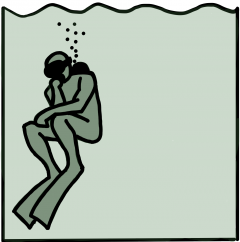In a recent article in GUE’s InDepth blog, Richard Walker argues that the correct unit to discuss the amount of (free) gas in a cylinder is l (litre) and not bar l (bar times litre) because that is the correct unit for a volume.
I would like to argue that although the latter is correct the former isn’t: The volume of the gas is not its amount. The amount is measured by counting the number of molecules or (if you don’t like big numbers) the number of moles of gas. Let’s look at the ideal gas law, the mother of all gas calculations (and of course including Boyle-Mariotte):
\(pV=nRT\)It’s the n on the right hand side (or nR depending on whether you count molecules or moles). As during diving, the temperature stays pretty much constant (or at least we don’t take changes in to account in our calculations) you could include that in the constant as well. Then the RHS (and thus the LHS) describes the diver’s version of amount of gas.
And that is not changed even when feeding it though a compressor (let’s still ignore the temperature change), when emptying the cylinder at the surface or when breathing it at 30m of depth at ambient pressure. This is the amount.
And you should measure it in the unit of this equation which is volume times pressure, which in SI derived unites is conveniently expressed in bar l.
Of course you can compute which volume this amount of gas fills at some pressure (be it 232 bar or 1 bar or 4 bar in the above examples), simply divide by that pressure. But when gas planning, you should plan the amount of gas you need (you will need it at different pressures) and that is measured (invariantly) in bar l.
I am sorry Rich, but I believe you are wrong here.


Very nuanced, but yes when he is saying “2400 litres” he means “2400 litres at 1 atmosphere.” Or something between 0.9 and 1.1 bar depending on atmospheric conditions. But kudos to GUE for working to abandon the stone age systems of Trumpistan–even if a bit arrogantly, as usual
The article mentions RHS and LHS but doesn’t say what they are. What did I miss? Richard Walker’s article seems quite reasonable to me. I would say that the correct way (if a bit pedantic) would be to say: 2,400 l @1ATA, just like I like to express SAC/RMV as 10 l/min @1ATA, for accuracy.
On the other hand, this “bar l” unit makes zero sense to me. And while I’m at it, it’s Boyle–Mariotte, not Boyle–Marotte.
RHS is right hand side (of the equation). I will fix the (autocorrect) typo, thanks for noticing.
Robert is right about the dimensional analysis, whether or not we are comfortable thinking in terms of bar * litres (aka L @1ATA in your parlance–they are roughly equivalent).
The GUE author’s mistake is in their equation 2. For correct dimensional analysis of the units, it should read: “12L * 200bar * (1bar / 4bar) = 600 bar L”. The author omitted an implicit comparison to surface pressure (1bar/4bar). Alternatively equation 2 could have also been expressed as “12L * 200bar / 4 = 600 bar L”. The relationship in pressures between surface and 30 metres can be correctly expressed either as “1bar/4bar” or simply “4”. But is not correctly expressed as either “1/4bar” nor “4bar”.
Cannot agree with Richard Walker, but cannot fully agree with you (Robert) either. I follow you to the point that the “amount is measured by counting the number of molecules” (quote from your blog text). But that leads to the conclusion that n cannot be identified with pV. If you were right, the unit “bar l” could be converted to “mol” and R times T would have to be dimensionless.
What you really demonstrated is just this: Under isothermal conditions, pressure times volume is _proportional_ to the amount of gas. There are many more more examples of proportional relations in physics, say Ohm’s law: Voltage is proportional to the electric current, U=RI. But would you really put it this way: “Voltage is (invariantly) measured in Ohm-Amps”?
I agree that is is proportional with the constant of proportionality being RT. I would argue that at fixed temperature, bar l is just an alternative unit to mol (which is arbitrary as well until one fixes Avogadro’s number to some value).
Maybe we just use language in different ways. I am happy with bar*l as an engineering unit. But I wouldn’t call it “an alternative unit to mol”. Mol is simply a natural number in the mathematical meaning of natural. In contrast, bar*l has the dimension mass times length squared divided by time squared, which is associated to the physical quantity called energy, heat or work. In my opinion, the dimension(s) need to be identical to use one unit as an alternative to another, say “bar” and “psi”.
I assume that you use the term “alternative unit” to describe the measuring process, right? For example, when we measure a temperature, we do not measure the physical quantity “temperature” directly. Commonly, we measure a voltage from a PTC/NTC resistor or a thermocouple. In our case, the combination of SCUBA tank plus pressure gauge is out instrument to measure the amount of gas we carry, and the reading is bar*l. Did I get you correctly?